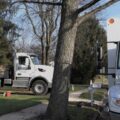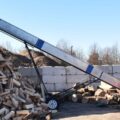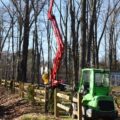Tree stress, while often overlooked, can significantly impact the health and longevity of the trees that shade our yards, line our streets, and define our local parks. Whether you’re in a bustling town like Lansdale or a quieter area like New Hope, your trees may be silently struggling with various stressors unique to our region.
This guide will explore the causes of tree stress common in eastern PA, how to identify stressed trees, and what local homeowners and professionals can do to help. With the right knowledge and care, we can ensure that the trees that make our communities special continue to thrive for generations to come.
Key Takeaways
- Trees can become stressed through human activity, such as poor mulching or planting, and natural problems, like excessive heat and drought.
- Typical signs of tree stress include early leaf drop, canopy dieback, leaf scorch, wilting leaves, cracked bark, and leaning.
- Fertilizer is a powerful tool for reducing tree stress, though we recommend using it sparingly. Pick a slow-release and balanced fertilizer that will provide nutrients to the soil over time.
- Adding supplemental water during a drought can help reduce tree stress. Established trees may only need watering during long periods with no rain, while recently-planted trees can benefit from regular watering during normal conditions.
- Other methods to reduce stress in trees include placing a layer of mulch around them, treating them for pests and diseases, and pruning to remove deadwood and decrease limbs rubbing together.
What is Tree Stress?
Tree stress occurs when environmental conditions make it difficult for a tree to thrive. Much like humans, trees under stress are more susceptible to health issues and have a harder time recovering from injuries or fighting off diseases and pests.

Common Causes of Tree Stress in Eastern PA
Tree stress can come from several factors. We can group these into two rough categories: human activity and environmental causes.
Human Activity Leading to Tree Stress
Well-intentioned but incorrect practices can harm trees, putting them under unnecessary stress. Com-mon activities that stress trees include:
- Improper planting: Some trees start behind the proverbial eight ball when they’re planted improperly. This can include planting a tree where it doesn’t have enough space or the proper sun exposure, in the wrong soil type, or at the wrong depth, among other things.
- Poor mulching technique: Mulch benefits trees, but too much around a tree can lead to waterlogged soil and potential root rot. For example, we often see mulch piled high around tree trunks (the notorious “mulch volcanoes”) in places like Central Park in Doylestown, which can suffocate roots and encourage decay.
- De-icing salts: Residents in urban environments (such as those living in the heart of Telford or Lansdale) or with trees near roads will have to worry about salt spray from de-icing salts. These salts change the soil chemistry and lead to dehydrated roots. Trees taking up the saline-rich water may develop leaf scorch when summer arrives.
- Lawn care injuries: Mowing or weed whacking around a tree can damage the bark and force the tree to expend energy to repair the damage, stressing the tree in the process.
- Poor pruning techniques: While regular pruning benefits trees, over-pruning or doing it wrong will cause stress to the tree. Avoid dramatic tree pruning like tree topping as this greatly stresses and can even kill a tree.
Environmental Tree Stressors
- Weather Extremes: Our hot, humid summers in the Delaware Valley can be tough on trees. The heat waves we experienced in recent years, like the one in June 2024 that hit Bucks County hard, can cause significant stress. Conversely, harsh winters with heavy snow and ice storms can damage branches and stress trees.
- Drought: Droughts are not uncommon in our area, with recent droughts still lingering in many’s memories. Even established trees may struggle during a drought, and without supplemental water, they will become stressed.
- Soil Issues: Many areas in our region, particularly in newer developments around King of Prussia or Warminster, have compacted or poor-quality soil. This limits root growth and nutri-ent uptake, especially for species like sugar maples that prefer well-drained, fertile soil.
- Urban Conditions: Trees in towns like Telford, Perkasie, or Quakertown face unique chal-lenges. Limited root space due to sidewalks and buildings, exposure to road salt during our snowy winters, and reflected heat from pavements all contribute to tree stress. The iconic syc-amores lining many of our historic streets are particularly vulnerable to these urban stressors.
- Pests and Diseases: Our region faces several tree health threats. The spotted lanternfly invasion has stressed many trees, especially in Berks and Montgomery counties. The emerald ash borer continues to threaten our ash trees, while bacterial leaf scorch affects many of our oak trees, particularly in older neighborhoods of Newtown and Yardley. Infestations and infections can make a stressed tree susceptible to further attacks and more vulnerable to heat and drought conditions.
How Stress Affects Trees
Stressed trees often show signs that something isn’t right. Look for symptoms such as:
- Early leaf drop or color change, which you might notice on the maples along the Delaware Ca-nal towpath in New Hope
- Wilting or scorched leaves, common in dogwoods during our hot summers
- Sparse canopy or dead branches, often seen in stressed pin oaks in older suburbs like Levit-town
- Cracks in the bark or trunk, which can be particularly problematic for our area’s cherry trees
- Leaning or unstable growth, sometimes observed in pines and spruces after heavy storms
If left unchecked, stress can lead to declining health and even tree death, changing the character of our local landscapes.
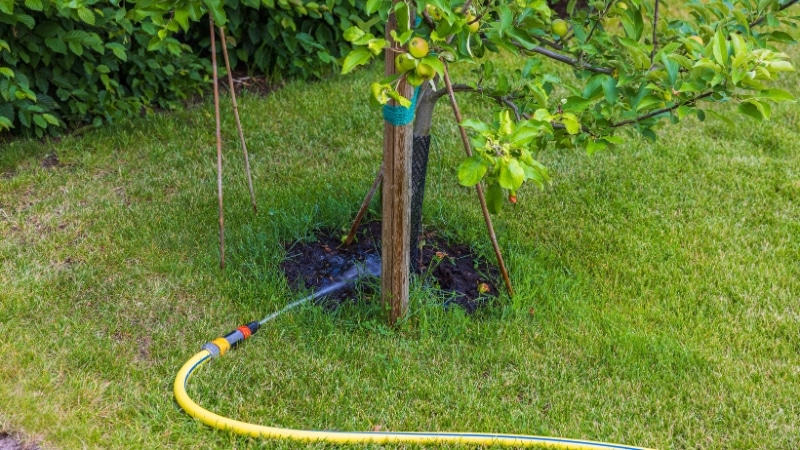
Professional Solutions for Tree Stress
At Clauser Tree Care, we offer several services to help reduce tree stress:
Soil Improvement for Stress Reduction in Trees
Healthy trees start with healthy soil. Our liquid fertilizer injections deliver nutrients directly to the root zone. This deep root fertilization service is an effective way to give your trees the nutrients they need to thrive in our eastern PA cli-mate, from the silty, poorly-draining soil around Doylestown to the more sandy soils near the Delaware River. This technique is particularly effective for mature trees in established neighborhoods like Chal-font or Hatfield, where soil nutrients may be depleted. It helps trees better withstand stress and pro-motes overall health.
Our team will also assess soil conditions on your property and can recommend amendments if needed. This is particularly important in areas with clay-heavy soils, common in parts of Upper Bucks County.
Proper Pruning to Alleviate Stressors
We remove dead or diseased branches, as well as branches rubbing against each other, and improve tree structure to reduce tree stress. We may also thin the tree canopy to allow better air circulation and light penetration. This type of tree pruning is especially important for trees damaged by recent storms. [https://www.clausertreecare.com/pruning-trimming/]
Pest and Disease Management
Trees may struggle when they are dealing with insect and disease problems on top of other stressors like excessive heat, broken branches, or bark wounds.
An arborist can inspect your trees, identify the exact problem, and then prescribe a treatment for various issues that may be stressing your trees. For example, we offer treatments for emerald ash borer, which has been detected in several Bucks County municipalities.
Some of the common tree diseases and pests we can help with in Bucks and Montgomery counties include:
- Anthracnose
- Fire blight
- Powdery mildew
- Apple scab
- Hemlock woolly adelgid
- Bacterial leaf scorch
- Emerald ash borer
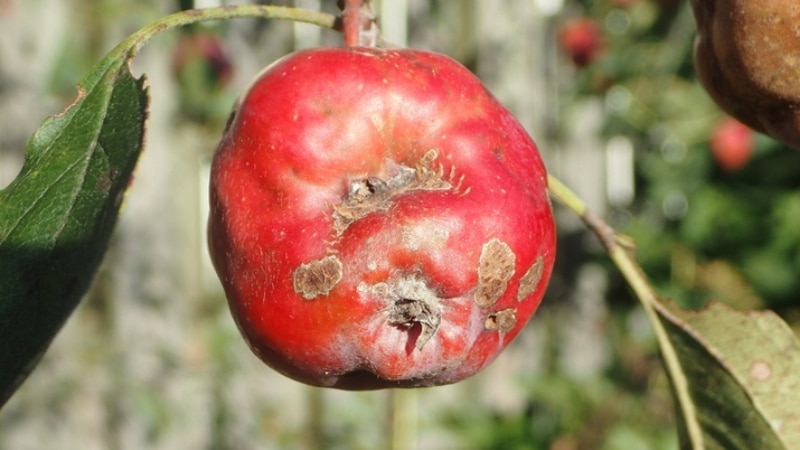
Trees in Bucks and Montgomery counties are under threat from numerous insects and diseases. Pictured here is an apple demonstrating the devastating effects of apple scab. Photo courtesy of Whitney Cranshaw, Colorado State University, Bugwood.org.
What Homeowners Can Do
You can also take steps to reduce stress on your trees:
Use Proper Mulching Techniques
Mulch is beneficial for trees, especially in urban areas or near streets. It mimics a forest floor environment, cooling the soil and reducing stress caused by heat-absorbing pavements.
To mulch correctly:
- Apply a 2-4 inch layer of mulch around the tree.
- Extend the mulch to the tree’s drip line if possible.
- Keep mulch away from the trunk, leaving a few inches of space.
- Ensure the root collar (where trunk meets roots) is visible.
The mulch ring should resemble a donut, not a volcano. Inspect and adjust your mulch periodically, adding more as it decomposes or removing excess that has shifted against the trunk.
Provide Supplemental Water During Drought
During dry spells, which are not uncommon in our area during late summer, water deeply but infre-quently to encourage deep root growth. This is especially important for newly planted trees or those in exposed locations.
While established trees rarely need extra water in normal conditions, they still benefit from supple-mental watering during prolonged drought. Here’s how to water effectively:
- Use an overhead sprinkler or soaker hose.
- Moisten soil 12-18 inches deep around the tree and slightly beyond its drip line (the farthest reaches of the tree canopy).
- Wait until the top 6 inches of soil are dry before watering again.
To check soil moisture, insert a probe (like a screwdriver) into the ground. If it penetrates easily and the soil feels cool and moist, watering isn’t necessary yet.
PRO TIP: Recently planted trees need supplemental watering even in non-drought condi-tions.
Avoid Trunk Damage
Be careful with lawn equipment near trees to prevent bark injury. This is especially important for thin-barked species like beech and maple, which are common in many of our local neighborhoods.
Monitor for Changes
Keep an eye out for any unusual changes in your trees and contact a professional if you’re concerned. Early intervention can often prevent more serious problems down the line.
Stressed Trees? Clauser Tree Care Can Help
At Clauser Tree Care, we have a deep understanding of the trees in our area and know how to reduce both environmental and human-caused stressors to trees. If you’re noticing signs of stress in your trees or want to be proactive about their health, give us a call at 215-542-8291 or request a quote online. We’re here to help keep the trees of Bucks and Montgomery counties healthy, beautiful, and stress-free.

About Clauser Tree Care
From who you talk to on the phone in our office, to our courteous and experienced work crews who provide your service, all of the hard-working team members at Clauser Tree Care strive for complete client satisfaction. Our job is simply not done until you are pleased with the experience that you have had working with our company. Founded more than 25 years ago on the principles of honest work and arboricultural best practices, we strive for a higher standard of care for a greener future.




